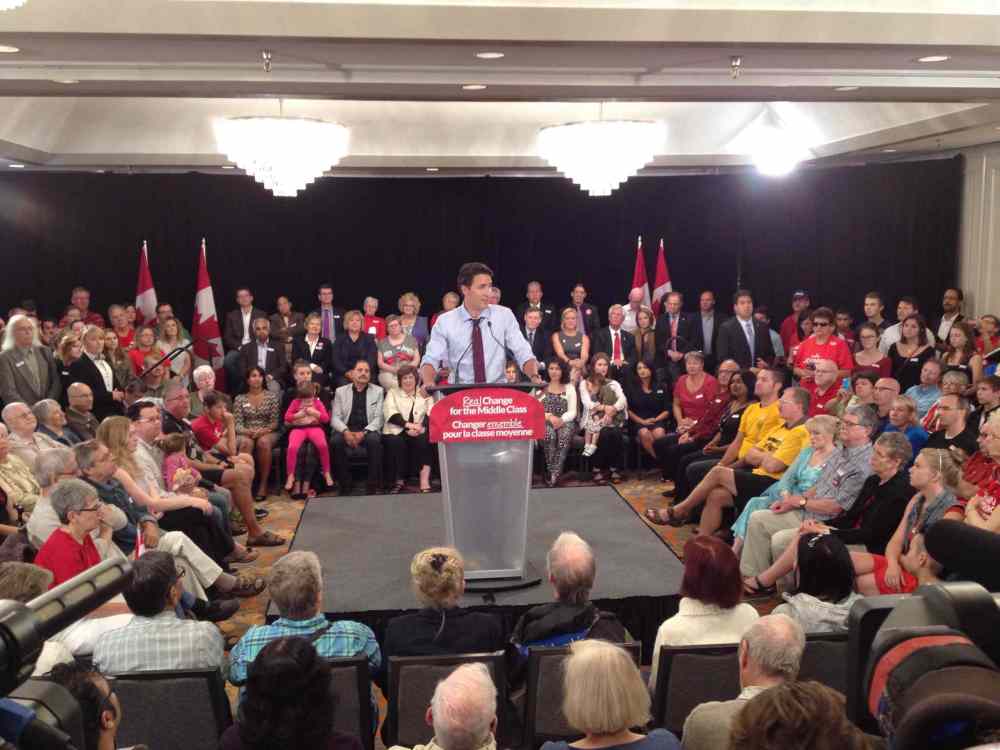Who is this middle class Trudeau is courting?
Advertisement
Read this article for free:
or
Already have an account? Log in here »
To continue reading, please subscribe:
Monthly Digital Subscription
$0 for the first 4 weeks*
- Enjoy unlimited reading on winnipegfreepress.com
- Read the E-Edition, our digital replica newspaper
- Access News Break, our award-winning app
- Play interactive puzzles
*No charge for 4 weeks then price increases to the regular rate of $19.00 plus GST every four weeks. Offer available to new and qualified returning subscribers only. Cancel any time.
Monthly Digital Subscription
$4.75/week*
- Enjoy unlimited reading on winnipegfreepress.com
- Read the E-Edition, our digital replica newspaper
- Access News Break, our award-winning app
- Play interactive puzzles
*Billed as $19 plus GST every four weeks. Cancel any time.
To continue reading, please subscribe:
Add Free Press access to your Brandon Sun subscription for only an additional
$1 for the first 4 weeks*
*Your next subscription payment will increase by $1.00 and you will be charged $16.99 plus GST for four weeks. After four weeks, your payment will increase to $23.99 plus GST every four weeks.
Read unlimited articles for free today:
or
Already have an account? Log in here »
Hey there, time traveller!
This article was published 19/08/2015 (3765 days ago), so information in it may no longer be current.
Even three weeks into the election campaign, it’s become clear Liberal Leader Justin Trudeau believes the path to glory in this election runs through the hearts and minds of a cynical, disadvantaged middle class.
It’s a fascinating political strategy that, theoretically, has the potential to be effective in an election involving an incumbent government that has done more for upper-income classes than ever before. And no matter how you define middle class, Canadians who find themselves above the poor but below the wealthy are, in demographic terms, the largest constituency among the electorate.
Mobilize that group and you have a great chance to win the election.

That is not to say Trudeau’s middle-class obsession is not completely without risks. Several of which were revealed in Winnipeg this week.
Wednesday morning, Trudeau kicked off a two-city, two-part policy pledge aimed at middle-class families.
Trudeau promised in Winnipeg to bring in provisions to allow workers in federally regulated industries (an estimated one-million people) to formally request flexible working conditions. These could include flexible start and finish times for their work days, extended family leave opportunities, and opportunities to work at home.
Later in the day, Trudeau was in Vancouver to promise more flexible EI parental benefits. This includes allowing people to take up to 18 months of parental leave intermittently rather than all at once, and an option to take a longer period of time off with reduced benefits.
In theory, both pledges sound notes that should resonate with middle-class voters. In reality, this strategy is a bit more problematic.
First, nobody knows how to define a middle-class Canadian, or whether anyone would willingly identify themselves as such. As a result, it’s hard to know whom Trudeau is talking to, and whether those who are affected are listening.
Going back as far as 2014, when Trudeau first signalled he was going to aim his message at the great but poorly defined middle class, he had few hard metrics to describe his target audience.
In the past, he has described the middle class in almost Tennessee Williams-like terms. To Trudeau, these are the people “who do most of the heavy lifting in our economy, who work longer and longer hours for an ever-shrinking piece of the pie, and less and less financial security.”
Again, that could describe a lot of different people of different income levels. In various debates in the House of Commons, Trudeau has elaborated and talked about Canadians who “live paycheque to paycheque.”
“People who live off their incomes are the middle class and those who live off their assets, their portfolios, their trust funds are not,” Trudeau has said in parliamentary debate. Again, no firm definition there.
It should be noted that the Liberals are not alone in their inability to define the middle class.
Finance Minister Joe Oliver’s assertion, in defense of his increased child-care benefits, claimed that families with incomes of as high as $120,000 quality as middle class. Economists and political strategists are still debating that one.
However, a lack of a firm definition is not the only problem with Trudeau’s ode to the middle class. Equally important is the fact that Trudeau’s pledges, while symbolically powerful, lack pragmatism.
You can encourage employers to allow greater flexibility for their employees. You can even tell them that flexibility can, in the right circumstances, result in greater employee engagement, discretionary effort and productivity. But no federal government can force an employer to act on a request from an employee, and that’s a pretty big flaw in the Liberal plan.
Trudeau frequently cited statistics from the United Kingdom, which has similar provisions protecting the right of employees to request flexible working arrangements. Trudeau said that in the U.K., employers honoured more than 80 per cent of all requests.
That example means this is not a pie in the sky idea. But in Canada, employers may need a bit more tough love to embrace the benefits of flexible working conditions. As it stands now, Trudeau’s pledge is moving political poetry, but underwhelming as law.
The Liberal obsession with the middle class is, obviously, a way of competing for voters that are well outside the Conservative core. Without a firm definition, it’s always hard to say there are no middle class voters supporting the Tories, but many believe Tory support comes from upper income brackets.
The Liberals also obviously feel that pandering to some romantic notion of the middle class is more powerful as a political tool than hard metrics. And that messages aimed at the middle class have a good opportunity to resonate with a large swath of voters, including those who have not voted in the recent past.
Even so, this is a huge, albeit fascinating risk for the Liberal leader. Tailoring his message to the middle class may seem like great strategy when competing with the Conservatives, but it’s quite possible it takes him directly into a death match with the NDP, a party that still brands itself the choice of average working Canadians.
If Trudeau is not landing hooks in his great white whale — the amorphous middle class with its economically unjust living conditions — then he and his party may find themselves pretty lonely characters come election day.
On the other hand, if there are many Canadians out there who are willing to wear the middle-class label, and feel that Conservative policies have ignored their interests, then this will be a risk with a huge payoff.
dan.lett@freepress.mb.ca

Dan Lett is a columnist for the Free Press, providing opinion and commentary on politics in Winnipeg and beyond. Born and raised in Toronto, Dan joined the Free Press in 1986. Read more about Dan.
Dan’s columns are built on facts and reactions, but offer his personal views through arguments and analysis. The Free Press’ editing team reviews Dan’s columns before they are posted online or published in print — part of the our tradition, since 1872, of producing reliable independent journalism. Read more about Free Press’s history and mandate, and learn how our newsroom operates.
Our newsroom depends on a growing audience of readers to power our journalism. If you are not a paid reader, please consider becoming a subscriber.
Our newsroom depends on its audience of readers to power our journalism. Thank you for your support.










